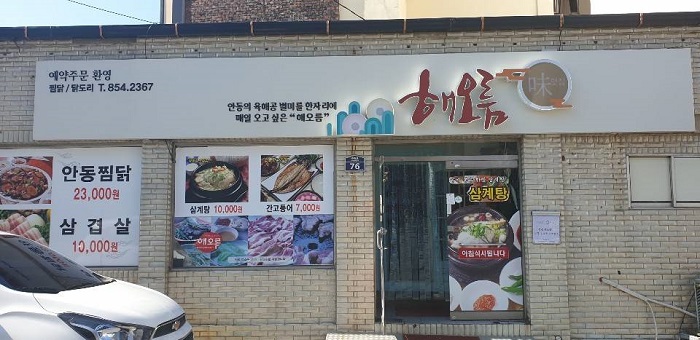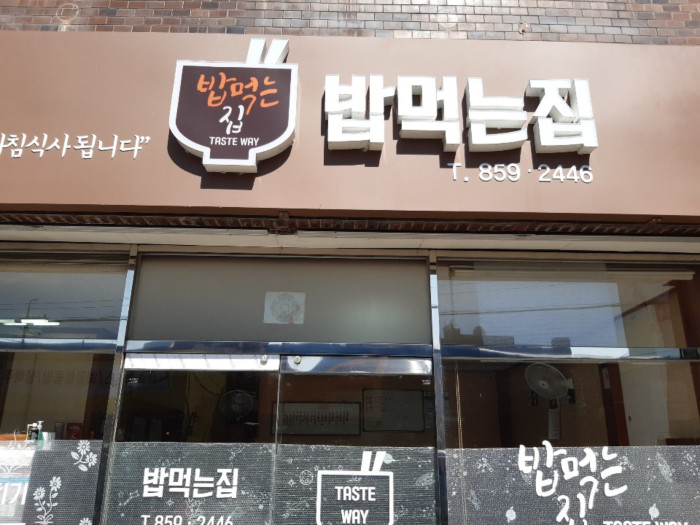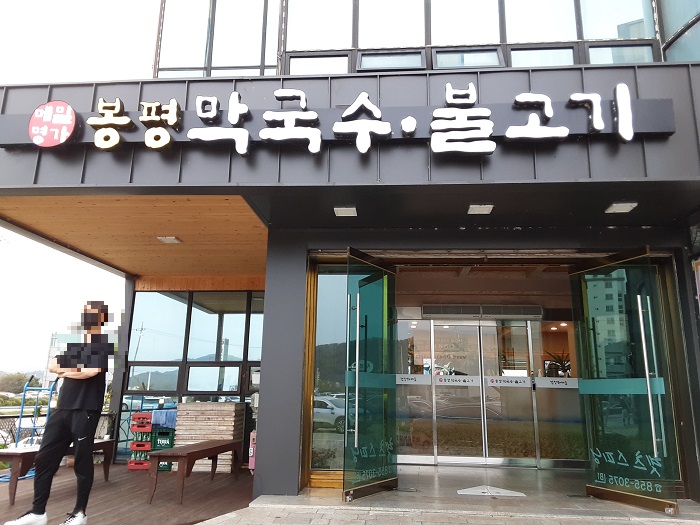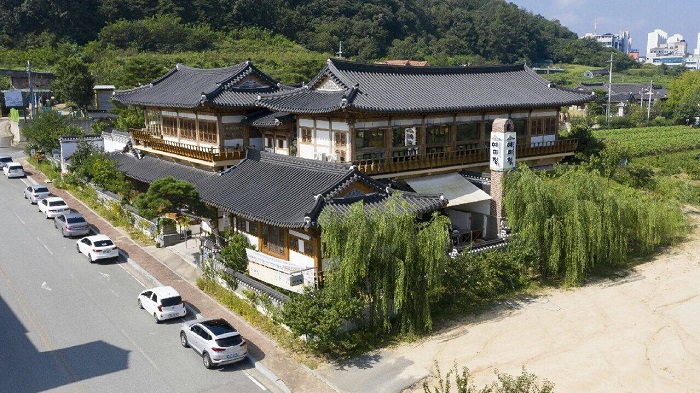Haeoreum (해오름)
19.5Km 2021-03-22
76, Jungang-ro, Andong-si, Gyeongsangbuk-do
+82-54-854-2367
A restaurant that sells not only grilled mackerel and jjimdak famous in Andong but also a variety of Korean dishes. This Korean dishes restaurant is located in Andong Station, Gyeongsangbuk-do. The most famous menu is grilled mackerel.
Bap Meokneun Jip (밥먹는집)
19.5Km 2021-03-26
77, Jungang-ro, Andong-si, Gyeongsangbuk-do
+82-54-859-2446
It is a place where you can enjoy various Korean side dishes. This restaurant's signature menu is kimchi stew. This Korean dishes restaurant is located in Andong-si, Gyeongsangbuk-do.
Bongpyeong Maemil (봉평메밀)
19.8Km 2021-03-26
323, Yuksa-ro, Andong-si, Gyeongsangbuk-do
+82-54-857-1501
A restaurant that uses noodles made directly by the chef using 100% buckwheat. This restaurant's signature menu is buckwheat noodles. This Korean dishes restaurant is located in Andong-si, Gyeongsangbuk-do.
Yemijeong (예미정)
20.0Km 2021-03-30
111, Ongjeonggol-gil, Andong-si, Gyeongsangbuk-do
+82-54-822-0500
It is a place that develops and sells Korean dishes, using family recipes, with a long history keeping tradition in Andong. This Korean table d'hote restaurant is located in Andong-si, Gyeongsangbuk-do. The representative menu is grilled salted mackerel.
Chunujae House / 춘우재고택
20.0Km 2025-03-05
101, Matjil-gil, Yecheon-gun, Gyeongsangbuk-do
+82-54-655-1717
Chunujaegotaek is an architectural house from the late Joseon period built by Gwon Jin (1568 - 1620). He was the grandson of Gwon Ui, the 10th generation of Gwon Su Hong who, in turn, is the founder of Bokyagongpa. Chunu is the name of Chunu Gwongjin which means “spring rain comes.” Is it because of the name? When rain drops fall on the Chunujae house, the fragrance of the hanok becomes more evident. In the yard are different fruit trees, peepal trees, and chrysanthemums. In particular, the chrysanthemums planted in front of the stone wall are natives to Korea and have witnessed the history of the house. Every year, the chrysanthemum petals are collected for tea brewing and the branches are soaked to make alcohol. A small stream runs outside the house, which makes for a pleasant sound. Staying in the hanok makes life elegant, restful, and idyllic. Currently, Gwon Chang Yong and his wife, the heir of the family, are living in the main room of the main building, maintaining the house. Unwilling to send off guests without meals, they provide breakfast. There are seven rooms in total but accommodation is only allowed on 2-3 floors in summer. Traditional Korean paste making experience is also conducted by Mrs. Gwon. A group of 10 or more is required to make a reservation in advance. Experience program varies depending on the season.
CHIAMGOTAEK [Korea Quality] / 치암고택 [한국관광 품질인증]
20.0Km 2023-04-13
297-10, Toegye-ro, Andong-si, Gyeongsangbuk-do
+82-54-858-4411, +82-10-3530-4413
Chiam Old House in Anmak-dong, Andong, Gyeongsangbuk-do is an old traditional Korean house once owned by Lee Man-hyeon(pen name Chiam) who was the 11th-generation descendant of “Toegye” Yi Hwang, one of the most prominent Korean Confucian scholars of the Joseon Dynasty and a high-ranking government official during the reign of King Gojong. This house was originally located in Wonchon-ri, Dosan-myeon but was relocated to its current location in 1976 after a flood caused by the collapse of Andong Dam. Chiam Old House consists of 22 rooms, 5 gates, and 1 detached building. The main building is taller than the detached building. One of the unique features of this detached building is that it has both gable roof and gambrel roof on either side. Listed as Gyeongsangbuk-do Folklore Material No. 11, Chiam Old House now serves as a guesthouse for those wishing to experience an old traditional Korean house. The rooms that are open to guests are “Seongmyeongjae,” “Gyeongeopjae,” and “Nakseongdang.” The large room called “Bakkatchae,” or outer building, is the most comfortable one to stay in for a night, since it's furnished with kitchen, TV, air conditioner, and bathroom. “Seongmyeongjae” means “honesty and integrity” in Korean. It’s an “ondol (Korean floor heating system)” room typical of any traditional Korean house, where you have to sleep on the floor. "Gyeongeopjae" is the most popular one among the guests, and its name means “unselfish and reverent.” The rooms next to the gate called “Ilgeonjae,” “Seokcheonjae,” and “Hakgujae” located along the wall are great places to stay if you want to see the surroundings and the old house at the same time. “Jamnyongdang” on the east side of the main building is named after the small pond in the yard, and it means “to strive to be a man of virtue like the dragon flying in the sky.” There are lots of beautiful flowers in the small garden in complete harmony with the old house and surrounding mountains, making it a great place to take a leisurely walk as you experience the history.




![CHIAMGOTAEK [Korea Quality] / 치암고택 [한국관광 품질인증]](http://tong.visitkorea.or.kr/cms/resource/31/2580131_image2_1.jpg)
 Français
Français
 한국어
한국어 English
English 日本語
日本語 中文(简体)
中文(简体) Deutsch
Deutsch Español
Español Русский
Русский